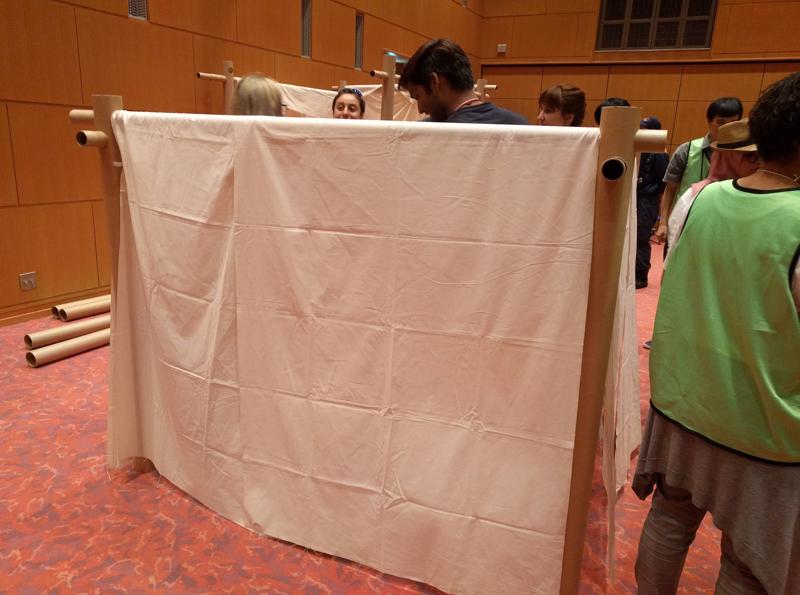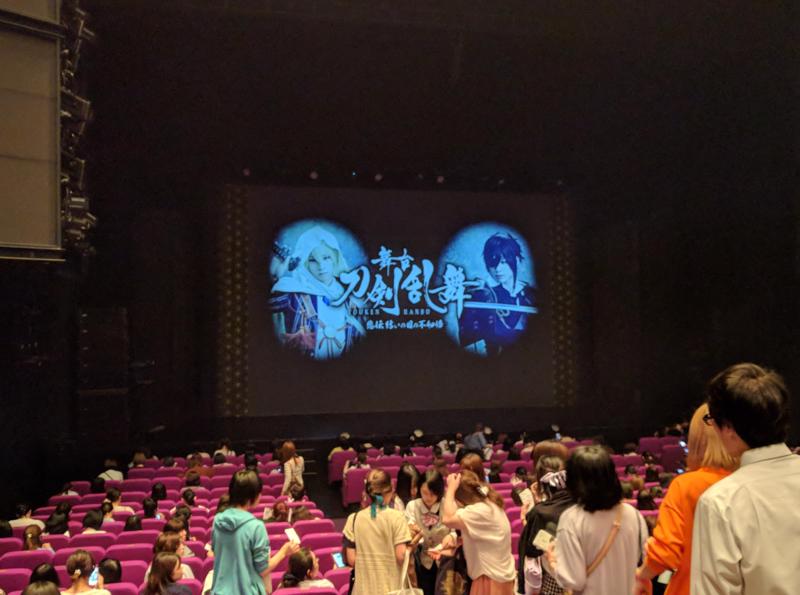Japan, Take 2
I did not eat any plums during this season, nor for any of the following 3 months.
So the Kyoto City International Foundation (Kokoka from here on out) organizes a bunch of events during the year for the foreign students in Kyoto take part in. I happened to register for their Emergency Evacuation training weekend for the experience, since the last time I
June 16 - 20 梅子黄 The Plums turn Yellow
June 18, 2018
|
Kyoto
I did not eat any plums during this season, nor for any of the following 3 months.
So the Kyoto City International Foundation (Kokoka from here on out) organizes a bunch of events during the year for the foreign students in Kyoto take part in. I happened to register for their Emergency Evacuation training weekend for the experience, since the last time I

did anything of the sort was back in elementary school (maybe high school?). It was interesting.
The event took place at the Kokoka building, and it was an over-nighter. We got to practice with fire extinguishers, CPR, building temporary privacy partitions, and even sit in an earthquake simulation. This will become important later.
All participants got a free sleeping bag, which we used that night as we slept on top of cardboard inside the meeting rooms of the Kokoka building. The next day was a morning of communal brainstorming of what to do during emergencies, and it was a good reminder session for what to keep in mind during natural disasters.
The next day, I woke up to noise that sounded a lot like the engines of the earthquake simulation truck, as well as shaking. Having JUST TRAINED FOR A SITUATION LIKE THIS, I immediately crawled over to the tiny little table I had to cover my head, and waited out the shaking. I could not help but to laugh at the timeliness of the training event, and then promptly removed the heavy stuff from my loft and put them on the ground. I did indeed literally laugh aloud both during and after the earthquake. When I conferred with my housemates and landlady afterward, I was still laughing at how I had just walked away from an earthquake simulation the day before only to immediately put my training to use.
This amusing story has a second portion. Now, as I have been documenting, I had been going to see 2.5 Musicals in hope to use this as a Doctoral Thesis topic, and had miraculously been able to get tickets to 2 different productions in April. There was one more that I really wanted to go see, the stage play version of the same IP from the first musical I had seen. I did not realize back in April that getting tickets to these things was not actually that easy, and that there is a complicated series of lotteries, general sales, and day-of sales that can happen before you might get a ticket. The stage play for Touken Ranbu was kinda the last of my list of "need to see this so I can have a good spread of raw data", but I had tried and failed to get tickets for both the lottery draw and the general ticket sales (General tickets sold out in like, half a hour. I couldn't do it online because the site doesn't allow for international credit card use, so I roped my landlady in to help me with getting tickets that morning. Still didn't work. My only option was to go physically to the convenience store to try and get the ticket from the ticket machine there, but it was occupied for the entire duration of that first half hour.). There was even a second wave of tickets that opened up, but they were very few in number and those were also gone almost immediately. I had just about given up on this show, BUT THEN THE EARTHQUAKE HAPPENED.
Since the theatre was actually in Kyoto this time, I could get there, but I knew the trains from Osaka were not running, as they had experienced the brunt of the earthquake. Many other trains were also not running into Kyoto, so I made the gambit to go down to the theatre to see if there would be any cancellations. I didn't realize there was a specific time window which one would have to apply for day-of tickets, and missed that window for the matinee show that day. It took me hours of waiting and asking (useless) staff before I finally found out what I needed to do to try to get day-of tickets. Since nothing else was happening that day, I just waited around the area until the day-of ticket lottery draw time came up for the evening show, and spent 20 mins of that half hour window downloading and installing the one special app they used for this show before I was finally able to put in for the lottery draw. Then it was more waiting, before I was notified half an hour before the show started that I was 10th in line for day-of seats. I was still not going to get my hopes up, because to have 10 extra seats in a "sold-out" theatre isn't exactly promising, and I had spent most of my waiting time thinking over the logistics of cancellations from a paper ticketing system (in other words, even if ppl couldn't show up for the show due to trains not running that day, there was no way they could inform the venue or the ticketing agency, and their seat would still be counted as occupied. So in reality, there is no "cancellation seat", just whatever extra seats they have in emergency areas....).
I did not breathe a sigh of relief until I was physically handing over cash for the seat.
Now that, is a miracle and I truly believe God came through for me. With that show, I now had 3 samples of the 2.5 Dimensional Theatre, all within a fairly consistent frame. One was the Touken Ranbu

musical, one was the Hakuouki musical, and one was the Touken Ranbu stage play. Two were the same IP, but different styles of production, and the third was also a "period" piece, taking place in the same Bakufu era that most anime and manga love to visit due to its transitional themes and costumes. I would have seen each production twice, once live in the theatre and once in the movie theatre for the simultaneous live broadcast of their final shows. Now THAT'S quality research.
1.
Foreword
2.
72 Seasons of Japan: 雪下出麦 Beneath the Snow the Wheat Sprouts (January 1-5)
3.
Pheasants are like peacocks, right? 雉始雊 The Pheasant's First Calls (January 16-20)
4.
January 21-24 款冬華 The Butterbur flowers
5.
January 25-29 水沢腹堅 Mountain Streams Freeze
6.
January 30-February 3 鶏始乳 The Hens start laying eggs
7.
February 4-8 東風解凍 Spring winds thaw the ice
8.
February 9-13 黄鶯睍睆 The Nightingale Sings
9.
February 14-18 魚上氷 Fish Rise from the Ice
10.
February 19-23 土脉潤起 The Earth becomes Damp
11.
February 24-28 霞始靆 Haze First Covers the Sky
12.
March 1–5 草木萌動 Plants Show First Buds
13.
March 6–10 蟄虫啓戸 Hibernating Creatures Open their Doors
14.
March 11–15 桃始笑 The First Peach Blossoms
15.
March 16–20 菜虫化蝶 Leaf Insects become Butterflies
16.
March 21-25 雀始巣 The Sparrow Builds her Nest
17.
March 26-30 櫻始開 The First Cherry Blossoms
18.
March 31-April 4 雷乃発声 Thunder Raises its Voice
19.
April 5-9 玄鳥至 The Swallows Arrive
20.
April 10-14 鴻雁北 Geese Fly North
21.
April 15-19 虹始見 The First Rainbow Appears
22.
April 20-24 葭始生 The First Reeds Grow
23.
April 25-29 霜止出苗 The Frost Stops; The Rice Grows
24.
April 30- May 4 牡丹華 The Tree Peony Flowers
25.
May 5-9 蛙始鳴 The First Frogs Call
26.
May 10-14 蚯蚓出 The Earth Worms Rise
27.
May 15-20 竹笋生 Bamboo Shoots Appear
28.
May 21-25 蚕起食桑 The Silk Worm Awakes and Eats the Mulberry
29.
May 26-30 紅花栄 The Safflower Blossoms
30.
May 31-June 5 麦秋至 The Time for Wheat
31.
June 5 - June 9 蟷螂生 The Praying Mantis Hatches
32.
June 10 - 15 腐草為螢 Fireflies rise from the Rotten Grass
33.
June 16 - 20 梅子黄 The Plums turn Yellow
34.
June 21 - June 25 乃東枯 The common Self-Heal Dries (Summer Solstice)
35.
June 26 - June 30 菖蒲華 The Iris Flowers
36.
July 1 - July 6 半夏生 The Crow-dipper Sprouts
37.
July 7 - July 11 温風至 Hot Winds Blow
38.
July 12 - July 16 蓮始開 The First Lotus Blossoms
39.
July 17 - July 21 鷹乃学習 The Young Hawk Learns to Fly
40.
July 22 - July 27 桐始結花 The First Paulownia Fruit Ripen
41.
July 28 - Aug 1 土潤溽暑 Damp Earth Humid Heat (Major Heat)
42.
Aug 2 - Aug 6 大雨時行 Heavy Rain Showers
43.
Aug 7 - Aug 11 涼風至 A cool Wind blows (First Autumn)
44.
Aug 12 - Aug 16 寒蝉鳴 The Evening Cicada Sings
45.
Aug 17 - Aug 22 蒙霧升降 Thick Fog Blankets the Sky
46.
Aug 23 - Aug 27 綿柎開 The Cotton Lint Opens (Limit of Heat)
47.
Aug 28 - Sept 1 天地始粛 Earth & Sky Begin to Cool
48.
Sept 2 - Sept 6 禾乃登 The Rice Ripens
49.
Sept 7 - Sept 11 草露白 Dew Glistens White on Grass
50.
Sept 12 - Sept 16 鶺鴒鳴 Wagtails Sing
51.
Sept 17 - Sept 21 玄鳥去 Swallows Leave
52.
Sept 22 - Sept 27 雷乃収声 Thunder Ceases (Autumn Equinox)
53.
Sept 28 - Oct 2 蟄虫坏戸 Insects hole up Underground
54.
Oct 3 - Oct 7 水始涸 Farmers Drain Fields
55.
Oct 8 - Oct 12 鴻雁来 The Geese Arrive
56.
November 19
Share your travel adventures like this!
Create your own travel blog in one step
Share with friends and family to follow your journey
Easy set up, no technical knowledge needed and unlimited storage!